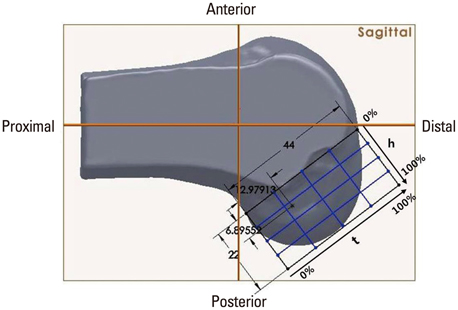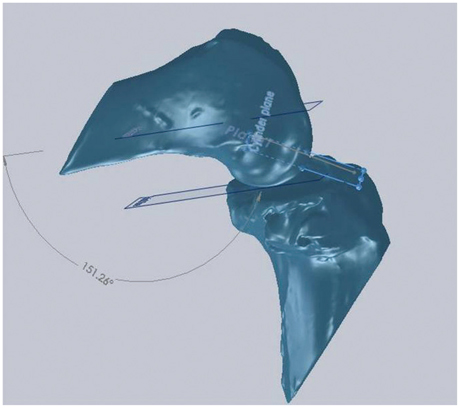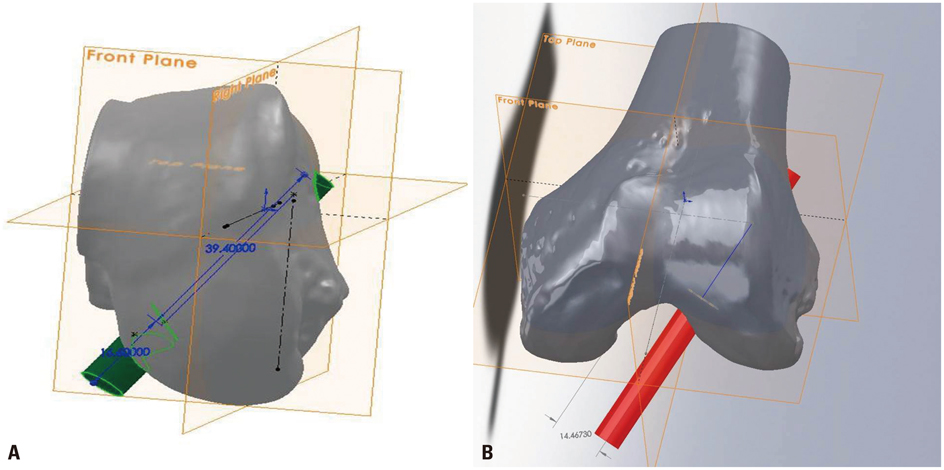Yonsei Med J.
2014 Nov;55(6):1584-1591. 10.3349/ymj.2014.55.6.1584.
Effect of Anteromedial Portal Entrance Drilling Angle during Anterior Cruciate Ligament Reconstruction: A Three-Dimensional Computer Simulation
- Affiliations
-
- 1Department of Orthopaedic Surgery, Military Hospital, Hongcheon, Korea.
- 2Department of Rehabilitation Medicine and Institute of Health Sciences, School of Medicine, Gyeongsang National University, Gyeongsang National University Hospital, Jinju, Korea.
- 3Department of Orthopaedic Surgery and Institute of Health Sciences, School of Medicine, Gyeongsang National University, Gyeongsang National University Hospital, Jinju, Korea. hscspine@hanmail.net
- KMID: 2070206
- DOI: http://doi.org/10.3349/ymj.2014.55.6.1584
Abstract
- PURPOSE
The object of this study was to evaluate entrance angle effects on femoral tunnel length and cartilage damage during anteromedial portal drilling using three-dimensional computer simulation.
MATERIALS AND METHODS
Data was obtained from an anatomic study performed using 16 cadaveric knees. The anterior cruciate ligament femoral insertion was dissected and the knees were scanned by computer tomography. Tunnels with different of three-dimensional entrance angles were identified using a computer simulation. The effects of different entrance angles on the femoral tunnel length and medial femoral cartilage damage were evaluated. Specifically, tunnel length and distance from the medial femoral condyle to a virtual cylinder of the femoral tunnel were measured.
RESULTS
In tunnels drilled at a coronal angle of 45degrees, an axial angle of 45degrees, and a sagittal angle of 45degrees, the mean femoral tunnel length was 39.5+/-3.7 mm and the distance between the virtual cylinder of the femoral tunnel and the medial femoral condyle was 9.4+/-2.6 mm. The tunnel length at a coronal angle of 30degrees, an axial angle of 60degrees, and a sagittal angle of 45degrees, was 34.0+/-2.9 mm and the distance between the virtual cylinder of the tunnel and the medial femoral condyle was 0.7+/-1.3 mm, which was significantly shorter than the standard angle (p<0.001).
CONCLUSION
Extremely low and high entrance angles in both of axial plane and coronal plane produced inappropriate tunnel angles, lengths and higher incidence of cartilage damage. We recommend that angles in proximity to standard angles be chosen during femoral tunnel drilling through the anteromedial portal.
Keyword
MeSH Terms
-
Aged
Anterior Cruciate Ligament/*surgery
Anterior Cruciate Ligament Reconstruction/instrumentation/*methods
Cadaver
Computer Simulation
Female
Femur/anatomy & histology/*surgery
Humans
Imaging, Three-Dimensional
Knee Joint/radiography/*surgery
Male
Middle Aged
Osteotomy/*methods
Outcome and Process Assessment (Health Care)
Patient Positioning
Surgical Instruments
Tomography, X-Ray Computed
Figure
Cited by 1 articles
-
A Comparison between Clinical Results of Selective Bundle and Double Bundle Anterior Cruciate Ligament Reconstruction
Yon-Sik Yoo, Si Young Song, Cheol Jung Yang, Jong Mun Ha, Yoon Sang Kim, Young-Jin Seo
Yonsei Med J. 2016;57(5):1199-1208. doi: 10.3349/ymj.2016.57.5.1199.
Reference
-
1. Bedi A, Maak T, Musahl V, O'Loughlin P, Choi D, Citak M, et al. Effect of tunnel position and graft size in single-bundle anterior cruciate ligament reconstruction: an evaluation of time-zero knee stability. Arthroscopy. 2011; 27:1543–1551.
Article2. Bowers AL, Bedi A, Lipman JD, Potter HG, Rodeo SA, Pearle AD, et al. Comparison of anterior cruciate ligament tunnel position and graft obliquity with transtibial and anteromedial portal femoral tunnel reaming techniques using high-resolution magnetic resonance imaging. Arthroscopy. 2011; 27:1511–1522.
Article3. Piasecki DP, Bach BR Jr, Espinoza Orias AA, Verma NN. Anterior cruciate ligament reconstruction: can anatomic femoral placement be achieved with a transtibial technique? Am J Sports Med. 2011; 39:1306–1315.4. Harner CD, Honkamp NJ, Ranawat AS. Anteromedial portal technique for creating the anterior cruciate ligament femoral tunnel. Arthroscopy. 2008; 24:113–115.
Article5. Järvelä T. Double-bundle versus single-bundle anterior cruciate ligament reconstruction: a prospective, randomize clinical study. Knee Surg Sports Traumatol Arthrosc. 2007; 15:500–507.
Article6. Kondo E, Yasuda K, Ichiyama H, Azuma C, Tohyama H. Radiologic evaluation of femoral and tibial tunnels created with the transtibial tunnel technique for anatomic double-bundle anterior cruciate ligament reconstruction. Arthroscopy. 2007; 23:869–876.
Article7. Lubowitz JH. Anteromedial portal technique for the anterior cruciate ligament femoral socket: pitfalls and solutions. Arthroscopy. 2009; 25:95–101.
Article8. Nishimoto K, Kuroda R, Mizuno K, Hoshino Y, Nagamune K, Kubo S, et al. Analysis of the graft bending angle at the femoral tunnel aperture in anatomic double bundle anterior cruciate ligament reconstruction: a comparison of the transtibial and the far anteromedial portal technique. Knee Surg Sports Traumatol Arthrosc. 2009; 17:270–276.
Article9. Pinczewski LA, Lyman J, Salmon LJ, Russell VJ, Roe J, Linklater J. A 10-year comparison of anterior cruciate ligament reconstructions with hamstring tendon and patellar tendon autograft: a controlled, prospective trial. Am J Sports Med. 2007; 35:564–574.
Article10. Siebold R, Webster KE, Feller JA, Sutherland AG, Elliott J. Anterior cruciate ligament reconstruction in females: a comparison of hamstring tendon and patellar tendon autografts. Knee Surg Sports Traumatol Arthrosc. 2006; 14:1070–1076.
Article11. Colvin AC, Shen W, Musahl V, Fu FH. Avoiding pitfalls in anatomic ACL reconstruction. Knee Surg Sports Traumatol Arthrosc. 2009; 17:956–963.
Article12. Harner CD, Poehling GG. Double bundle or double trouble? Arthroscopy. 2004; 20:1013–1014.
Article13. Basdekis G, Abisafi C, Christel P. Influence of knee flexion angle on femoral tunnel characteristics when drilled through the anteromedial portal during anterior cruciate ligament reconstruction. Arthroscopy. 2008; 24:459–464.
Article14. Chang CB, Yoo JH, Chung BJ, Seong SC, Kim TK. Oblique femoral tunnel placement can increase risks of short femoral tunnel and cross-pin protrusion in anterior cruciate ligament reconstruction. Am J Sports Med. 2010; 38:1237–1245.
Article15. Choi NH, Lee JH, Victoroff BN. Do broken cross-pins compromise stability after anterior cruciate ligament reconstructions with hamstring tendons? Arthroscopy. 2007; 23:1334–1340.
Article16. Golish SR, Baumfeld JA, Schoderbek RJ, Miller MD. The effect of femoral tunnel starting position on tunnel length in anterior cruciate ligament reconstruction: a cadaveric study. Arthroscopy. 2007; 23:1187–1192.
Article17. Hamilton SC, Jackson ER 2nd, Karas SG. Anterior cruciate ligament femoral tunnel drilling through anteromedial portal: axial plane drill angle affects tunnel length. Arthroscopy. 2011; 27:522–525.
Article18. Piefer JW, Pflugner TR, Hwang MD, Lubowitz JH. Anterior cruciate ligament femoral footprint anatomy: systematic review of the 21st century literature. Arthroscopy. 2012; 28:872–881.
Article19. Anderson K, Seneviratne AM, Izawa K, Atkinson BL, Potter HG, Rodeo SA. Augmentation of tendon healing in an intraarticular bone tunnel with use of a bone growth factor. Am J Sports Med. 2001; 29:689–698.
Article20. Weiler A, Hoffmann RF, Bail HJ, Rehm O, Südkamp NP. Tendon healing in a bone tunnel. Part II: histologic analysis after biodegradable interference fit fixation in a model of anterior cruciate ligament reconstruction in sheep. Arthroscopy. 2002; 18:124–135.21. Takeda Y, Iwame T, Takasago T, Kondo K, Goto T, Fujii K, et al. Comparison of tunnel orientation between transtibial and anteromedial portal techniques for anatomic double-bundle anterior cruciate ligament reconstruction using 3-dimensional computed tomography. Arthroscopy. 2013; 29:195–204.
Article22. Yasuda K, Kondo E, Ichiyama H, Kitamura N, Tanabe Y, Tohyama H, et al. Anatomic reconstruction of the anteromedial and posterolateral bundles of the anterior cruciate ligament using hamstring tendon grafts. Arthroscopy. 2004; 20:1015–1025.
Article23. Greis PE, Burks RT, Bachus K, Luker MG. The influence of tendon length and fit on the strength of a tendon-bone tunnel complex. A biomechanical and histologic study in the dog. Am J Sports Med. 2001; 29:493–497.
Article24. Yamazaki S, Yasuda K, Tomita F, Minami A, Tohyama H. The effect of intraosseous graft length on tendon-bone healing in anterior cruciate ligament reconstruction using flexor tendon. Knee Surg Sports Traumatol Arthrosc. 2006; 14:1086–1093.
Article25. Weiler A, Peine R, Pashmineh-Azar A, Abel C, Südkamp NP, Hoffmann RF. Tendon healing in a bone tunnel. Part I: biomechanical results after biodegradable interference fit fixation in a model of anterior cruciate ligament reconstruction in sheep. Arthroscopy. 2002; 18:113–123.26. Bernard M, Hertel P, Hornung H, Cierpinski T. Femoral insertion of the ACL. Radiographic quadrant method. Am J Knee Surg. 1997; 10:14–21.27. Bird JH, Carmont MR, Dhillon M, Smith N, Brown C, Thompson P, et al. Validation of a new technique to determine midbundle femoral tunnel position in anterior cruciate ligament reconstruction using 3-dimensional computed tomography analysis. Arthroscopy. 2011; 27:1259–1267.
Article28. Shin YS, Ro KH, Lee JH, Lee DH. Location of the femoral tunnel aperture in single-bundle anterior cruciate ligament reconstruction: comparison of the transtibial, anteromedial portal, and outside-in techniques. Am J Sports Med. 2013; 41:2533–2539.
Article29. Lubowitz JH, Konicek J. Anterior cruciate ligament femoral tunnel length: cadaveric analysis comparing anteromedial portal versus outside-in technique. Arthroscopy. 2010; 26:1357–1362.
Article30. Luites JW, Wymenga AB, Blankevoort L, Kooloos JG. Description of the attachment geometry of the anteromedial and posterolateral bundles of the ACL from arthroscopic perspective for anatomical tunnel placement. Knee Surg Sports Traumatol Arthrosc. 2007; 15:1422–1431.
Article31. Zantop T, Ferretti M, Bell KM, Brucker PU, Gilbertson L, Fu FH. Effect of tunnel-graft length on the biomechanics of anterior cruciate ligament-reconstructed knees: intra-articular study in a goat model. Am J Sports Med. 2008; 36:2158–2166.
Article32. Loh JC, Fukuda Y, Tsuda E, Steadman RJ, Fu FH, Woo SL. Knee stability and graft function following anterior cruciate ligament reconstruction: comparison between 11 o'clock and 10 o'clock femoral tunnel placement. 2002 Richard O'Connor Award paper. Arthroscopy. 2003; 19:297–304.
Article33. Scopp JM, Jasper LE, Belkoff SM, Moorman CT 3rd. The effect of oblique femoral tunnel placement on rotational constraint of the knee reconstructed using patellar tendon autografts. Arthroscopy. 2004; 20:294–299.
Article34. Simmons R, Howell SM, Hull ML. Effect of the angle of the femoral and tibial tunnels in the coronal plane and incremental excision of the posterior cruciate ligament on tension of an anterior cruciate ligament graft: an in vitro study. J Bone Joint Surg Am. 2003; 85-A:1018–1029.35. Bedi A, Raphael B, Maderazo A, Pavlov H, Williams RJ 3rd. Transtibial versus anteromedial portal drilling for anterior cruciate ligament reconstruction: a cadaveric study of femoral tunnel length and obliquity. Arthroscopy. 2010; 26:342–350.
Article36. Siebold R, Benetos IS, Sartory N, He Z, Hariri N, Pässler HH. How to avoid the risk of intraoperative cartilage damage in anatomic four tunnel double bundle anterior cruciate ligament reconstruction. Knee Surg Sports Traumatol Arthrosc. 2010; 18:64–67.
Article
- Full Text Links
- Actions
-
Cited
- CITED
-
- Close
- Share
- Similar articles
-
- Femoral Tunnel Drilling Techniques in Anterior Cruciate Ligament Reconstruction
- Three-Dimensional Reconstruction Computed Tomography Evaluation of the Tunnel Location and Angle in Anatomic Single-Bundle Anterior Cruciate Ligament Reconstruction: A Comparison of the Anteromedial Portal and Outside-in Techniques
- Single Bundle Anterior Cruciate Ligament Reconstruction
- Preparation of the Femoral Tunnel through Anteromedial Portal during Arthroscopic Single Incision Anterior Cruciate Ligament Reconstruction
- Open anterior cruciate ligament reconstruction using inside-out femoral drilling






